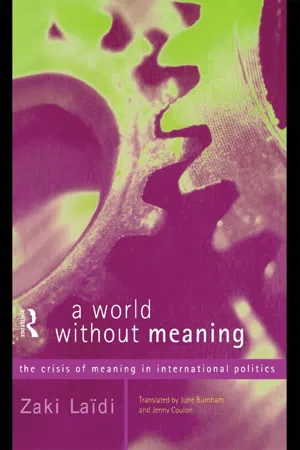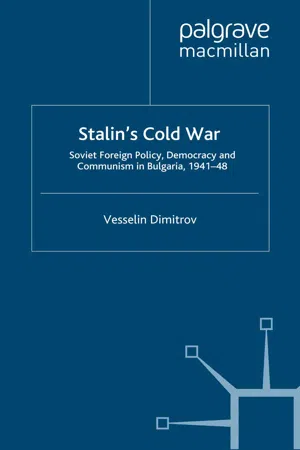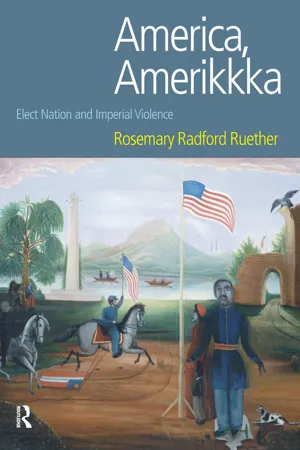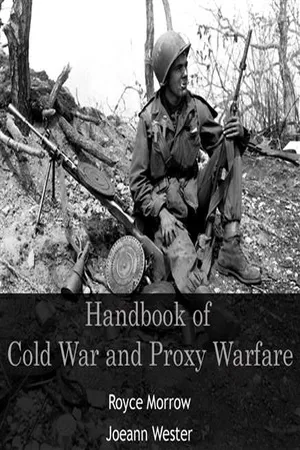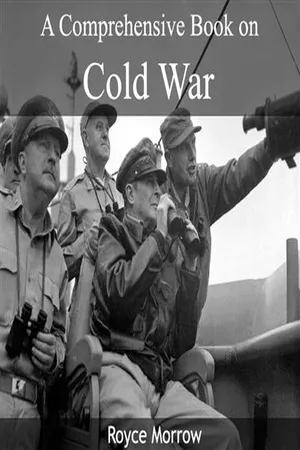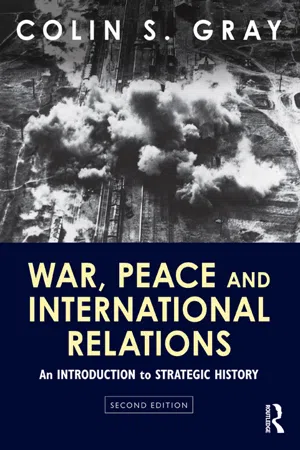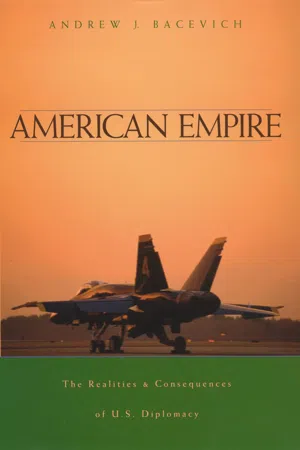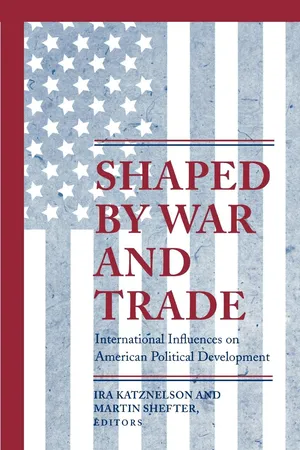History
America in the Cold War
The Cold War was a period of geopolitical tension between the United States and the Soviet Union from the end of World War II until the early 1990s. America played a central role in the Cold War, engaging in a variety of strategies to contain the spread of communism and promote its own interests. This era was characterized by intense political, military, and ideological rivalry between the two superpowers.
Written by Perlego with AI-assistance
Related key terms
1 of 5
11 Key excerpts on "America in the Cold War"
- eBook - ePub
A World Without Meaning
The Crisis of Meaning in International Politics
- Zaki Laidi, June Burnham, Jenny Coulon(Authors)
- 2005(Publication Date)
- Routledge(Publisher)
1The meaning of the Cold WarThe more the Cold War fades into the distance, the more we shall be obliged to think of it, re-read it and reinterpret it not only geopolitically but also in cultural terms. We shall discover—doubtless risking over-rationalization of the past— how original this moment in history was in the way it was able, over an exceptionally long period, to reorder the main world issues around a battle for the appropriation of meaning. Within half a century the Cold War managed to ‘encompass’ very large-scale political, economic, social and cultural transformations: the decolonization of the Third World, the growth in economic power of Japan and Germany, the Sino-Soviet split, and the proliferation of bloody regional conflicts. It also managed to incorporate economic and sociological realities as fundamental as the decline of the industrialization strategy to the advantage of the service sector, the erosion of the Keynesian model, the blossoming of individualist values, the development of mass culture and the subsequent atomization of demands.1A ‘tragic system’
But this ‘moment in history’ was not restricted to channelling the shifts in world power or conscientiously fanning regional conflicts. It enabled the pursuit, strengthening and perhaps completion of the long, slow, linear process of the historical transfer of meaning that, over the centuries, had fixed itself in succession on religion, nationalism and finally ideology, that great ‘mythogenous’ factor of the twentieth century.2 Indeed, it managed to combine two absolutes: meaning, symbolized by the ideological combat between two universal and competing value-systems; and power, carried by the absolute weapon, the nuclear bomb.Between 1917 and 1945, all the seeds of an ideological confronta tion had unquestionably been sown. At the same time as the Bolsheviks were seizing the Winter Palace, the American president, Woodrow Wilson, was already drafting the contours of a new order that could raise aloft the flag of democracy in the world.3 - eBook - PDF
Stalin's Cold War
Soviet Foreign Policy, Democracy and Communism in Bulgaria, 1941-48
- V. Dimitrov(Author)
- 2007(Publication Date)
- Palgrave Macmillan(Publisher)
2 Studies of British foreign policy, whilst reflecting the main lines of the more developed American debate, have tended to perceive the Cold War as one stage in the long saga of British imperial decline, and thus focus on problems such as the extent to which Britain was able to play an independent role in the gestation of the global conflict. The importance of Eastern Europe in that process is widely recognized, in situations as varied as the secret ‘percentages’ agreement between Churchill and Stalin in October 1944 and the dramatics of Churchill’s ‘Iron Curtain’ speech in 1946. An important limitation of the American and British Cold War histori- ography is the perception of the conflict as primarily a clash of great powers on the international level, and a relative lack of awareness of its potential for triggering internal political confrontation. For instance, whilst Gaddis has recognized the importance of democratic politics and bureaucratic institutions in constraining the choices of American policy- makers, 3 he has not explored in depth the role of the Cold War as a div- isive issue in the American political system. This is understandable, given the fact that in the United States and Britain, the Cold War did not become a battle on the domestic front to any significant degree; whilst there were differences between the left and the right on the exact nature of the policies to be pursued, there was an overall consensus on the values of liberal democracy and on a policy of containment towards the totali- tarian threat posed by the USSR. 4 By contrast, in most continental 2 Stalin’s Cold War European countries, as Geir Lundestad has perceptively demonstrated, the Cold War was fought internally as much as on the diplomatic front. 5 In countries such as France and Italy, strong communist parties took part in coalition governments after the Second World War and posed a serious potential challenge to liberal democracy. - eBook - ePub
America, Amerikkka
Elect Nation and Imperial Violence
- Rosemary Radford Ruether(Author)
- 2014(Publication Date)
- Routledge(Publisher)
America's Global Mission: The Cold War Era, 1945-89
DOI: 10.4324/9781315711201-6For more than forty years two rival empires, identified with two rival ideologies, confronted one another across bristling shields of deadly weapons capable of destroying the peoples of the earth many times over. Each defined themselves in messianic terms as saviors of the world’s peoples against a deadly foe. The U.S. saw itself as the leader of the ‘free world,’ champion of freedom and democracy, against an evil system of totalitarian repression and slavery. The Soviets saw themselves as the leader of an ‘inevitable’ process of world transformation from capitalist exploitation of the workers to socialist equality, over against a United States that had taken up the banner of European imperialism at a time when that system was dying.Stages in the Cold War
The period from 1945 to 1989 was not one of uniform hostility. It took several years after the end of the Second World War for the wartime alliance of the U.S. and Western Europe with the Soviet Union to be redefined as one of unrelenting antagonism. After the death of Stalin in 1953 until the late sixties there was some relaxing of tensions followed by renewed periods of hostility. The period from 1969–1979 was one of détente in which both sides pursued negotiations to resolve major issues of dispute, particularly the nuclear arms race. SALT I, (Strategic Arms Limitation Treaty) signed by President Nixon and Soviet leader Brezhnev in 1972, ended the race to develop defensive antiballistic missile systems (AMBs) and froze the number of nuclear missiles to 1,600 on the Soviet side and 1,054 on the U.S. side. This agreement actually left the U.S. two to one ahead, since the U.S. MIRVs (multiple independently targeted reentry vehicles) contained multiple warheads on one missile capable of hitting widely separated areas.11 Walter LaFeber, America, Russia and the Cold War, 1945–1992 - eBook - PDF
The Brief American Pageant
A History of the Republic, Volume II: Since 1865
- David Kennedy, Lizabeth Cohen, Mel Piehl, , David Kennedy, Lizabeth Cohen, Mel Piehl(Authors)
- 2016(Publication Date)
- Cengage Learning EMEA(Publisher)
The wartime “Grand Alliance” of the United States, the Soviet Union, and Britain had been a misbegotten child of necessity. When the hated Hitler fell, suspicion and rivalry between communistic, despotic Russia and capitalistic, democratic America were all but inevi-table. In a fateful progression of events, marked often by misperceptions as well as by genuine conflicts of interest, the two powers provoked each other into a tense standoff known as the Cold War . Enduring four and a half decades, the Cold War not only shaped Soviet–American relations; it overshadowed the entire postwar international order in every corner of the globe. Shaping the Postwar World Despite these obstacles, the United States did manage at war’s end to erect some of the structures that would support Roosevelt’s vision of an open world. At the Bretton Woods Conference in Bretton Woods, New Hampshire in 1944, the Western Allies established the International Monetary Fund (IMF) to encourage world trade and the World Bank to promote economic growth in war-ravaged and underdeveloped areas. Three years Cold War (1946–1991) The forty-five-year-long diplomatic tension between the United States and the Soviet Union that divided much of the world into polarized camps, capitalist against communist. Most of the international conflicts during that period, particularly in the developing world, can be traced to the competition between the United States and the Soviet Union. Bretton Woods Conference (1944) Meeting of Western allies to establish a postwar international economic order to avoid crises like the one that spawned World War II. Led to the creation of the International Monetary Fund (IMF) and the World Bank, designed to regulate currency levels and provide aid to underdeveloped countries. - No longer available |Learn more
- (Author)
- 2014(Publication Date)
- College Publishing House(Publisher)
______________________________ WORLD TECHNOLOGIES ______________________________ Chapter 4 Cold War (1953–1962) 1962 World map of alignments: NATO member states Other allies of the USA Colonized countries Warsaw Pact member states Other allies of the USSR Non-aligned nations The Cold War (1953–1962) discusses the period within the Cold War from the death of Soviet leader Joseph Stalin in 1953 to the Cuban Missile Crisis in 1962. Following the death of Stalin unrest occurred in the Eastern Bloc, while there was a calming of international tensions, the evidence of which can be seen in the signing of the Austrian State Treaty reuniting Austria, and the Geneva Accords ending fighting in Indochina. However, this thaw was only partial with an expensive arms race continuing during the period. Eisenhower and Khrushchev When Dwight D. Eisenhower was sworn in as U.S. President in 1953, the Democrats lost their two-decades-long control of the U.S. presidency. Under Eisenhower, however, the United States' Cold War policy remained essentially unchanged. Whilst a thorough rethinking of foreign policy was launched (known as Operation Solarium), the majority of emerging ideas (such as a ______________________________ WORLD TECHNOLOGIES ______________________________ rollback of Communism and the liberation of Eastern Europe) were quickly regarded as unworkable. An underlying focus on the containment of Soviet communism remained to inform the broad approach of U.S. foreign policy. An important strand in American politics of this period was McCarthyism. Named after Wisconsin Senator Joseph McCarthy, this was a period of intense anti-communism which lasted from 1948 to about 1956. The government of the United States prosecuted the leadership of the Communist Party USA as well as other individuals suspected of being communists. McCarthy's career faltered in 1954 as his hearings were televised for the first time, allowing the public and press to view his tactics. - No longer available |Learn more
- (Author)
- 2014(Publication Date)
- Learning Press(Publisher)
______________________________ WORLD TECHNOLOGIES ______________________________ Chapter- 4 Cold War (1953–1962) 1962 World map of alignments: NATO member states Other allies of the USA Colonized countries Warsaw Pact member states Other allies of the USSR Non-aligned nations The Cold War (1953–1962) discusses the period within the Cold War from the death of Soviet leader Joseph Stalin in 1953 to the Cuban Missile Crisis in 1962. Following the death of Stalin unrest occurred in the Eastern Bloc, while there was a calming of international tensions, the evidence of which can be seen in the signing of the Austrian State Treaty reuniting Austria, and the Geneva Accords ending fighting in Indochina. However, this thaw was only partial with an expensive arms race continuing during the period. ______________________________ WORLD TECHNOLOGIES ______________________________ Eisenhower and Khrushchev When Dwight D. Eisenhower was sworn in as U.S. President in 1953, the Democrats lost their two-decades-long control of the U.S. presidency. Under Eisenhower, however, the United States' Cold War policy remained essentially unchanged. Whilst a thorough rethinking of foreign policy was launched (known as Operation Solarium), the majority of emerging ideas (such as a rollback of Communism and the liberation of Eastern Europe) were quickly regarded as unworkable. An underlying focus on the containment of Soviet communism remained to inform the broad approach of U.S. foreign policy. An important strand in American politics of this period was McCarthyism. Named after Wisconsin Senator Joseph McCarthy, this was a period of intense anti-communism which lasted from 1948 to about 1956. The government of the United States prosecuted the leadership of the Communist Party USA as well as other individuals suspected of being communists. McCarthy's career faltered in 1954 as his hearings were televised for the first time, allowing the public and press to view his tactics. - N. Bisley(Author)
- 2004(Publication Date)
- Palgrave Macmillan(Publisher)
While the confrontation – socio-economic, geopolitical and ideologi- cal conflict – of this time was pre-eminently visible in domestic terms, it also had clear international aspects. The confrontation during this period was pre-dominantly between the USSR and the European powers, particularly Britain in the 1920s and Germany in the 1930s. That said, Soviet–American relations are illustrative of the underlying acrimony and ideological competition which in time underpinned the Cold War. For example, the reason why the United States did not recognise the Soviet government until 1933 was due, not only to the Soviet repudia- tion of debt and confiscation of property, but also due to the Soviet government’s failure to adhere to the norms of the international system, particularly the non-interference norm, and most specifically its overt revolutionary aims and practices. 25 The language of US State Department officials prior to the recognition was clear: ‘the fundamen- tal obstacle in the way of the establishment with Russia of the relations usual between nations in diplomatic intercourse is the world revolu- tionary aims and practices of the rulers of that country’. 26 William C. Bullitt, the US ambassador to Moscow, writing to the Secretary of State in July 1935 makes clear the sense of international The Cold War and the Soviet State 11 confrontation: ‘it is my conviction that there has been no decrease in the determination of the Soviet government to produce world revolu- tion’. 27 For Bullitt the peaceful international political posture of the 1930s was merely a tactical respite, as he puts it ‘reculer pour mieux sauter’. 28 The following year, he wrote to the Secretary of State regarding the broad direction of US policy towards the Soviet Union.- eBook - ePub
War, Peace and International Relations
An introduction to strategic history
- Colin S. Gray(Author)
- 2013(Publication Date)
- Routledge(Publisher)
Why was it so difficult for the West to make peace with the Soviet Union (and vice versa)? Why did the Cold War endure for more than forty years? One could cite geopolitical rivalry, the key roles of individuals, and contingency, but pride of place needs to be accorded to ideology. The evidence strongly suggests that the Cold War could not end until the Soviet Union abandoned a state ideology which mandated definition of capitalist powers as enemies. When Gorbachev retired the ideology, the Cold War was over. Unfortunately for him, though, the abrupt retirement of Marxism to the dustbin of history also removed the basis for the legitimacy of the Soviet state. It may be worth noting that, at the time of writing (slightly more than a decade into the twenty-first century), the People's Republic of China has not renounced its legitimizing political ideology, yet that legacy (or burden) from the past is not a noteworthy player in contemporary Sino-American security relations. The master narrative of global international relations has to accommodate significant variations from historical case to case.The story now must turn to consider explicitly the meaning of the nuclear discovery and the implications of the subsequent strategic revolution.Key points- Cold War history is hotly contested today.
- World War II had revolutionary consequences for all the contexts of international relations.
- The Cold War emerged slowly, by a process of interaction between rivals, from 1944 until 1947, or even 1950 (the war in Korea).
- Because of geopolitics, ideology and personality (especially Stalin's), the conflict was unavoidable.
- The Soviet Union was fatally outclassed in economic strength by the United States.
- Although it was inevitable that the Soviet Union would lose the competition, it was not inevitable that it would accept such defeat peacefully.
Questions- Who or what caused the Cold War?
- Why did the Cold War last for forty years?
- Why did the Cold War not conclude with World War III?
- Did the Soviet Union expire mainly for internal reasons or was external pressure an important factor?
Further reading
G. S. Barrass, The Great Cold War: A Journey through the Hall of Mirrors (Stanford, CA: Stanford University Press, 2009).R. Crockatt, The Fifty Years War: The United States and the Soviet Union in World Politics, 1941–1991 - eBook - PDF
American Empire
The Realities and Consequences of U.S. Diplomacy
- Andrew J. Bacevich, Andrew J. BACEVICH(Authors)
- 2009(Publication Date)
- Harvard University Press(Publisher)
Thanks to the unstinting courage and sacrifice of the American people, we were able to win that Cold War. 3 In such a rendering of the tale, “we” acted as one; doubts, divisions, disappointments disappear. By reciting this sanitized version of the postwar era, Clinton not only affirmed its essential truth but also situ-ated himself among those who fought the good fight against totalitar-ianism on behalf of democracy. The myth of the reluctant superpower also curbs any inclination to consider anew the purposes served by America’s now unquestioned global dominance. In a post–Cold War world, does the paradigm of America having “greatness thrust upon it” retain its explanatory power? If so, with the United States now clearly on the top of the heap, who or what is doing the thrusting? These questions go un-asked. Foreign policy “debate,” such as it is, confines itself to matters of tactics: Are the sanctions working? Will bombing alone suffice? How could we have been surprised? As if by default, the hallowed precepts of liberal internationalism perdure. That those precepts imply a conception for marrying instruments of national power to broad policy objectives serving concrete Ameri-can interests goes unmentioned and all but unnoticed. Instead politi-cians, abetted by the media, offer political theater: Republicans berate a Democratic president for failing to articulate a foreign policy “vi-sion”; given the chance, Democrats return the favor. Lost amidst the posturing is the extent to which both parties and virtually the entire foreign policy elite tacitly share a common vision and conform in practice to a strategic consensus of long standing. ➤ On two occasions during the century of America’s rise to global preeminence, critics mounted a vigorous challenge to that consensus. - eBook - PDF
- K. Aldred, Martin A. Smith(Authors)
- 1999(Publication Date)
- Palgrave Macmillan(Publisher)
44 The second and, to some extent at least, complementary inter- pretation of the sources of Soviet weakness places the emphasis on the Soviet Union’s relatively limited superpower scope and role when compared to the United States. It has been argued that the Soviet Union was unable to fully compete with the United States in terms of power projection because it ultimately lacked the econ- omic resources to underwrite such a competition. Some have argued from a longer historical perspective that the Soviet Union, as the successor to Imperial Russia, remained locked into traditional Russian strategic thinking which focused on building up influence over ter- ritories close to its existing borders rather than further afield across the seas. In this vein, Jan Nijman, in 1993, compared the Cold War spheres of influence of the US and the USSR and concluded that they confirmed ‘the notions of the Soviet Union as a regional land power, and the United States as a global sea power’. 45 The initial tenor of Soviet policy and outlook in the Cold War period was, of course, determined by Stalin. It has frequently been argued since his death in 1953, not least by some of his successors, The Two Cold War Superpowers 33 that he overestimated the importance of military strength as the single most important factor of power. There is evidence, however, that Stalin did believe that the economic and political aspects of power were important too. During the 1930s in particular he had been especially preoccupied with the forced development of Soviet heavy industry. Although this produced a narrow and limited in- dustrial base, and the social costs which the Soviet people had to pay for Stalin’s industrialisation drive were exceedingly heavy, econ- omists have conceded that some impressive statistical results were achieved. - eBook - PDF
Shaped by War and Trade
International Influences on American Political Development
- Ira Katznelson, Martin Shefter, Ira Katznelson, Martin Shefter(Authors)
- 2018(Publication Date)
- Princeton University Press(Publisher)
The advent of the superpower rivalry and the invention of nuclear weapons created pres- sures for a considerable expansion in the peacetime powers of the American state. During the formative, opening stages of the Cold War, however, these pressures were met by countervailing, antistatist influences. The power-cre- ating institutions put into place in the 1940s and 1950s can best be under- stood as the product of a collision between these two sets of forces. Let me close with some brief, speculative comments on the impact of these institu- tions, both on the United States and on the outcome of the Cold War. A power-creating program that constrained extraction, constricted the scope of the state's directive activities, and relied heavily on private institu- tions for the performance of key functions proved to be quite sustainable. Persistent efforts to extract even more money and manpower, or to impose a higher degree of centralized control over the American economy, would have stimulated greater domestic political resistance and might, in the long run, have undermined public support for containment. O n the other hand, the widespread use of contracts helped to create groups in American society with a strong interest in "staying the course," and, of course, in the continu- ation of the substantial expenditures necessary to do so. The program of power creation necessary to support a military strategy of flexible response probably also had fewer distorting internal effects than the most likely alternatives. Although it is impossible to say with certainty, it seems plausible that even bigger budgets, and the stronger central planning effort necessary to prepare the United States for all-out conventional or nu- clear war, would have had a greater and more damaging impact on the American economy. The implications for the nation's political life of a state endowed with far greater directive and extractive powers are uncertain, but potentially troubling.
Index pages curate the most relevant extracts from our library of academic textbooks. They’ve been created using an in-house natural language model (NLM), each adding context and meaning to key research topics.
